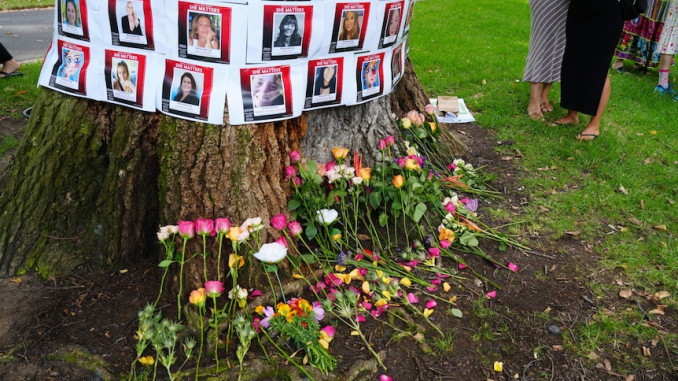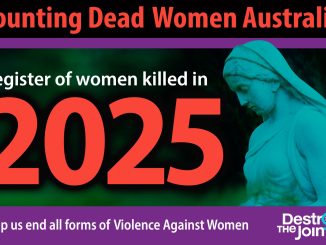
On March 15, 2025, people held a rally outside Parliament House in Canberra to commemorate over 100 women who have lost their lives due togender violence at the beginning of 2024. Not only in Canberra, but also in Sydney, Brisbane and other places, rallies against gender-based violence were also held. This is a stark reminder that despite years of government commitments, the crisis is still deepening.
Source: ABC News
According to the organization Counting Dead Women, about 79 women died from gender violence in 2024, and about 18 more have died in 2025.” While the number of women dying from violence keeps increasing, this tragic issue has been called a “national shame” by experts. On April 28, 2024, the Prime of Australiab given the opinion that gender violence to women in Australia had become a significant siutation, and about every four days that one woman would be killed. Yet, although growing public protests, high-profile summits, and government commitments, violence against women continues to worsen.
“I am a victim of assault so that’s dear and near to my heart but also seeing the list of names continuously grow, it’s very disheartening as a woman in this country.” Dot Sulmon took four hours to travel to the rally.
Source: ABC News: Alexandra Alvaro
Death toll rises despite state measures
In recent years, the government of Australia has promised to take strong steps to make women safer. This includes working with states, checking current systems, changing gender ideas, and making new laws. The government, along with the states and territories, has made a national plan from 2022 to 2032 to stop violence against women and children, and they are working together to make it happen. The government has donated A$2.3 billion in the 2022-23 and 2023-24 budgets to realise the results of the national plan. In addition, the Family Law Act 1975 has also been updated. This includes better sharing of information between the Family Court and groups like child protection, police, and gun control agencies.
However, two years later, this commendable plan has not yielded any results in real life, and gender-based violence continues to escalate.
It is well known that only a small percentage of violent murders are shown to the public. There are still countless women living in unhealthy relationships. A total of 34 women died in 2022–23 because of violence from a current or former partner, which is 28% more than the year before, breaking a long-term downward trend.
The plan could not be realized in large part because of a lack of political will and financial support.
Dr Brown, a domestic and sexual violence specialist in Alice Springs thought that the problem is not necessarily with the plan itself, but with the plan and its goals not being backed by investment. The budget indicates that at least AUD 3 billion is needed each year to implement the necessary prevention and support measures on a large scale, but the government’s actual funding is far less than these figures.
Causes behind gender-based violence
Despite increased public awareness and government attention, gender-based violence remains a deep-rooted problem in Australia. I think the core of the problem is the misogyny that is displayed in society through social media. According to Butler (2024), YouTube and TikTok algorithms may be directing young people to violent content, and many parents may not understand what videos their children are seeing.
Remy Young, a student who has lived in Sydney for half a year, told me that social media is crazy, “Problem is, the toxic stuff spreads faster ’cause it’s more “clickable.” My mates here say they see sexist posts all the time. Overall, it’s pretty harmful, honestly.” The government has also responded to this by launching a series of publicity and education activities against the phenomenon of hatred against women in online media.
At the same time, according to Canales and Kolovos (2025), “systemic” barriers prevent victims from seeking fair, about 92% of women choosing not to report a sexual assault to the police. The justice system has failed these women, with extremely low conviction and prosecution rates. This has led to an increase in gender-based violence.
What should we do in the future?
There is no single answer to stopping gender-based violence in Australia. It requires sustained and multifaceted efforts.
Implement national plans: The government of Australia must increase funding for gender-based violence prevention and support. “They have been told very loudly and very clearly by a systematically under-resourced and underfunded domestic and family violence and sexual sector that the investment is critical,” Dr Brown said.
In addition, the government can invest in GPS tracking of repeat offenders of gender-based violence to prevent similar incidents from happening again.
Strengthen legal protection and law enforcement: Improve laws and regulations. Treat gender-based violence as seriously as other public safety incidents and strengthen training for police, judges, and others.
Men’s role in the solution: According to News Desk (2024), all violent deaths of women are caused by men—often by men they know. Men must also be part of the solution.
“We need to talk about this stuff early, like in high school. Not just don’t hit women, but teaching guys how to handle emotions without aggression—like, actual anger management.” Remy added. It is very important for men to take part, not only to stop gender-based violence, but also to change ideas that support sexism and unfair treatment of women.
Support and assist survivors: The voices of those who have experienced gender-based violence are crucial. The government and relevant departments must listen to the demands and suggestions of victims and their families, and provide them with long-term safe housing and trauma counseling.
Today, women in Australia are still living in an environment where gender-based violence is rampant. Australian women have waited too long. It is time to make greater efforts and changes to unite the entire country and the people to fight for the right to safety and dignity for women in Australia and around the world.


Be the first to comment